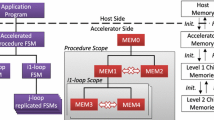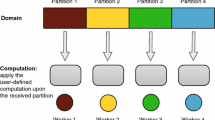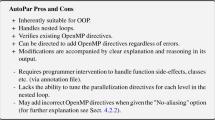Abstract
In this paper, the state-of-the-art parallel computational model research is reviewed. We will introduce various models that were developed during the past decades. According to their targeting architecture features, especially memory organization, we classify these parallel computational models into three generations. These models and their characteristics are discussed based on three generations classification. We believe that with the ever increasing speed gap between the CPU and memory systems, incorporating non-uniform memory hierarchy into computational models will become unavoidable. With the emergence of multi-core CPUs, the parallelism hierarchy of current computing platforms becomes more and more complicated. Describing this complicated parallelism hierarchy in future computational models becomes more and more important. A semi-automatic toolkit that can extract model parameters and their values on real computers can reduce the model analysis complexity, thus allowing more complicated models with more parameters to be adopted. Hierarchical memory and hierarchical parallelism will be two very important features that should be considered in future model design and research.
Similar content being viewed by others
References
Valiant L. A bridging model for parallel computation. Communication of ACM, 1990, 33:103–111
Cook S, Reckhow R. Time Bounded Random Access Computers. Journal of Computer and Systems Sciences, 1973, 7:354–375
Maggs B M, et al. Models of Parallel Computation: A Survey and Synthesis. In: Proceedings of 28th Hawaii Int. Conf. on System Sciences. Wailea, USA. 1995, 61–70
Fortune S, Wyllie J C. Parallelism in random access computers. In: Proceedings of the Tenth Annual ACM Symposium on Theory of Computing, USA. 1978, 114–118
Goldschlager L M. A Universal interconnection pattern for parallel computers. Journal of the ACM, 1982, 29(4):1073–1086
Culler D, et al. LogP: towards a realistic model of parallel computation. In: Proceedings of PPoPP’93. USA. May, 1993, 1–12
JáJá Joseph F, Kwan W R. The block distributed memory model. IEEE Transaction on Distributed and Parallel Systems, 1996, 7(8):830–840
Aggarwal A, et al. Communication complexity of PRAMs. Theoretical Computer Science, 1990, 71(1):3–28
Aggarwal A, ALpern B, Chandra A, et al. A model for hierarchical memory. In: Proceedings of the 19th Annual ACM Symp. on Theory of Computing. New York: ACM, 1987, 305–314
Aggarwal A, Alpern B., Chandra A., et al. Hierarchical Memory with Block Transfer. In: Proceedings of the 28th IEEE Symp. on Foundations of Computer Science. USA. 1987, 204–216
Alpern B, et al. The uniform memory hierarchy model of computation. Algorithmica, 1994, 12(2/3):72–109
Li Z Y, et al. Models and resource metrics for parallel and distributed computation. In: Proceedings of 28th Hawaii International Conference on System Sciences. USA. 1995, Vol. 2, 51–60
Zhang Y Q. Performance optimizations on parallel numerical software package and study on memory complexity. Dissertation of Doctoral Degree. Beijing, P.R. China: Institute of Software, Chinese Academy of Sciences, 2000 (in Chinese)
Qiao X Z, et al. HPM: a hierarchical model for parallel computations. International Journal of High Performance Computing and Networking (IJHPCN), 2004, 1(1/2/3):117–127
Dymond P W, et al. Parallel RAMs with owned global memory and deterministic context-free language recognition. Journal of the ACM, 2000, 47(1):16–45
Cole R., et al. The APRAM: incorporating asynchrony into the PRAM model. In: Proceedings of the 1st Annual ACM SPAA’89. USA. 1989, 169–178
Gibbons P B. A more practical PRAM model. In: Proceedings of the 1st Annual ACM Symposium on Parallel Algorithms and Architectures, USA. 1989, 158–168
Valiant L G. General Purpose Parallel Architectures. In: Leeuwen J V, ed. Handbook of theoretical computer science (vol. A): algorithms and complexity. Cambridge, MA, USA. MIT Press, 1991, 943–973
Mehlhorn K, Vishkin U. Randomized and deterministic simulations of PRAMs by parallel computers with restricted granularity of parallel memories. Acta Informatica, 1984, 21(4):339–374
Gibbons P, et al. The QRQW PRAM: accounting for contention in parallel algorithms. In: Proceedings of the 5th annual ACM-SIAM SODA’94, USA. 1994, 638–648
Gibbons P B, Matias Y, Ramachandran V. Can a shared-memory model serve as a bridging model for parallel computation? In: Proceedings of SPAA’97, USA, 1997, 72–83
Aggarwal A, et al. Communications complexity of PRAMs, Theoretical Computer Science, 1990, 71(1):3–28
Aggarwal A, etc. On Communication Latencies in PRAM Computations, Proc. of the 1st Annual ACM Symposium on Parallel Algorithms and Architectures, USA, 1989, 11–21
Mansour Y, et al. Trade-offs between communication throughput and parallel time. In: Proceedings of the 26th Ann. ACM Symposium on Theory of Computing, Canada, 1994, 372–381
de la Torre P, Kruskal C P. Towards a single model of efficient computation in real parallel computers. Future Generation Computer Systems, Elsevier Science Publishers, 1992, 8(4):395–408
Heywood T, Ranka S. A practical hierarchical model of parallel computation: I. the Model. Journal of Parallel and Distributed Computing, 1992, 16(3):212–232
Campbell D K G.. A survey of models of parallel computation. Technical Report No.YCS-97-278. Department of Computer Science, University of York, March 1997
Leiserson C, Maggs B. Communication efficient parallel algorithms for distributed random access computers. Algorithmica, 1988, Vol. 3:53–77
Upfal E. Efficient schemes for parallel communication. Journal of the ACM, 1984, 31(3):507–517
Bar-Noy A, Kipnis S. Designing broadcasting algorithms in the postal model for message passing systems. In: Proceedings of the SPAA’92, USA, 1992, 13–22
Snyder L. Type architectures, shared memory, and the corollary of modest potential. Annu. Review of Computer Science, 1986, Vol. 1:289–317
Hill J, McColl B, Stefanescu D, et al. BSPlib: the BSP Programming Library, Parallel Computing, 1998, 24(14):1947–1980
BSP Worldwide: http://www.bsp-worldwide.org
McColl W F, Tiskin A. Memory-efficient matrix multiplication in the BSP model. Algorithmica, 1999, 24(3/4):287–297
Chen G L, Xu J B. Communication strategy of butterfly computation on LogP model. Chinese Journal of Computer, 1997, 20(8):695–701 (in Chinese)
Chen G L, Li X F, Huang W M. The design and analysis of parallel FFT algorithm on three parallel computational models. Journal of Software, 1996, 17:57–63 (in Chinese)
Li X F, Shou B. Improvement of LogP model and optimization of FFT algorithm. Journal of computer research and development, 1996, 33(6) (in Chinese)
Gu N J, Li W, Liu J. Fibonacci series-based multicast algorithm. Chinese Journal of Computer, 2002, 25(4):365–372 (in Chinese)
Alexandrov A, Ionescu M, Schauser K E, et al. LogGP: incorporating long messages into the LogP model-one step closer towards a realistic model for parallel computation. In: Proceedings of 7th Annual Symposium on Parallel Algorithms and Architecture, USA, 1995, 95–105
Ino F, Fujimoto N, Hagihara K. LogGPS: a parallel computational model for synchronization analysis. In: Proceedings of the PPoPP’01, USA, 2001, 133–142
Morirz C A, Frank M I. LoGPC: modeling network contention in message passing programs. In: Proceedings of SIGMETRICS’98, USA, 1998, 254–263
Campbell D K G. Clumps: a candidate model of efficient, general purpose parallel computation. PhD Thesis. Department of Computer Science, University of Exeter, October, 1994
Ji Y C, Ding W Q, Chen G L, et al. A realistic parallel computational model. Chinese Journal of Computer, 2001, 24(4):437–441 (in Chinese)
Yan Y, Zhang X D, Song Y S. An effective and practical performance prediction model for parallel computing on nondedicated heterogeneous NOW. Journal of Parallel and Distributed Computing, 1996, 37(2):63–80
Luccio F, Pagli L. A model of sequential computation with pipelined access to memory. Theory of Computing Systems, Springer New York, 1993, 26(4):343–356
Vitter J, Shriver E. Algorithms for parallel memory II: hierarchical multi-level memories. Algorithmica, 1994, 12(2/3):148–169
Cameron K, Sun X H. Quantifying locality effect in data access delay: memory logP. In: Proceedings of the 2003 IEEE International Parallel and Distributed Processing Symposium, France, 2003, 48b
Cameron K W, et al. Lognp and Log3p: accurate analytical model of point-to-point communication in distributed systems. IEEE Transactions on Computers, 2007 (in press)
Cameron K W, Ge R. Predicting and evaluating distributed communication performance. In: Proceedings of the 2004 ACM/IEEE conference on Supercomputing, USA, 2004, 43
Zhang Y Q, et al. Memory complexity in high performance computting. In: Proceedings of the Third International Conference on High Performance Computing in Asia-Pacific Region, Singapore, 1998, 142–151
Snyder L. Type architectures, shared memory, and the corollary of modest potential. Annu. Review of Computer Science, 1986, Vol. 1:289–317
Niedermeier R, Rossmanith P. PRAM’s towards realistic parallelism: BRAM’s. In: Proceedings of the 10th International Symposium on Fundamentals of Computation Theory, Springer-Verlag Lecture Notes in Computer Science, Germany, 1995, Vol. 965, 363–373
Hambrusch S E, Khokhar A. C3: a parallel model for coarse-grained computers. Journal on Parallel and Distributed Computing, 1996, 32(2):139–154
Zhang Y Q. DRAM(h): a parallel computation model for high performance numerical computing. Chinese Journal of Computers, 2003, 26(12):1660–1670
Cooperman G, et al. Static performance evaluation for memory-bound computing: the MBRAM model. In: Proceedings of the International Conference on Parallel and Distributed Processing Techniques and Applications, 2004
Browne S, et al. A portable programming interface for performance evaluation on modern processors. The International Journal of High Performance Computing Applications, 2000, 14(3):189–204
Author information
Authors and Affiliations
Corresponding author
Rights and permissions
About this article
Cite this article
Zhang, Y., Chen, G., Sun, G. et al. Models of parallel computation: a survey and classification. Front. Comput. Sc. China 1, 156–165 (2007). https://doi.org/10.1007/s11704-007-0016-1
Received:
Accepted:
Issue Date:
DOI: https://doi.org/10.1007/s11704-007-0016-1




